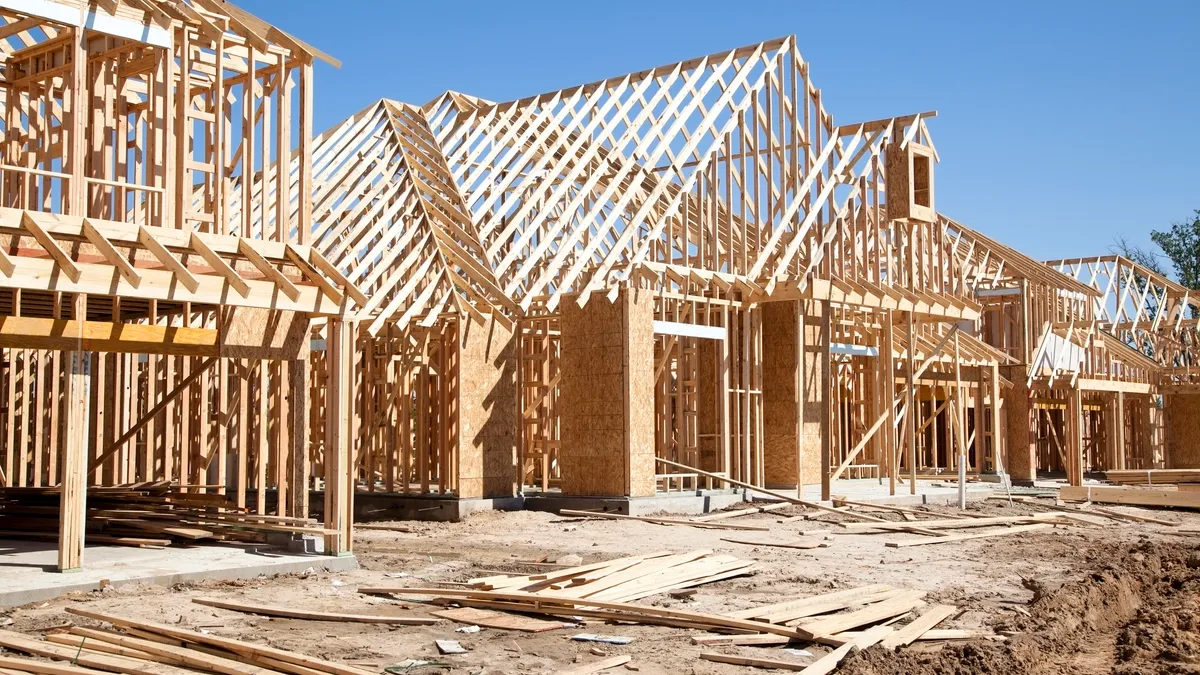Dive Brief:
- The housing industry downturn is poised to push the U.S. economy into a mild recession this year, according to the National Association of Home Builders’ chief economist.
- Elevated inflation and mortgage rates coupled with the high building material and construction costs that have plagued the industry since the start of the COVID-19 pandemic continue to take a toll on residential contractors, Rob Dietz said at a press briefing at the International Builders’ Show Tuesday in Las Vegas.
- 2022 was the first time in 11 years that single-family starts declined, falling an estimated 12% to 999,000 units, the NAHB reported. “Our thesis is that recession is underway,” Dietz said.
Dive Insight:
Dietz noted that the home building industry is a bellwether for the health of the entire U.S. economy.
“We’ve never had a period where home prices have declined and there has not been a recession,” he said. “I think the rest of the economy will feel it in 2023 via slowing economic output and rising job losses.”
NAHB is projecting negative GDP growth for the first two quarters of 2023. Two sequential quarters of economic contraction is one traditional indicator of a recession.
Although home prices are declining in many U.S. markets, it has not been enough to boost housing demand. Affordability conditions continue to deteriorate, as mortgage rates have more than doubled since the beginning of 2022, Dietz said.
The difference between a 3% and 6% mortgage rate can add more than $700 per month to the cost of a typical home loan. As a result, NAHB is forecasting that home prices could fall as much as 15% in 2023 following a nearly 40% gain since the pandemic began.
Interest rate outlook
NAHB is also forecasting that the Federal Reserve will raise short-term rates by another 25 basis points in February and a final quarter-point increase in March, according to a press release.
The NAHB believes the cumulative effect of the central bank’s rate hikes will be a peak rate of just above 7%. But looking forward, the group expects mortgage rates to fall below 6% by 2024.
“Falling rates will set the stage for a housing rebound later in 2023, and a better affordability environment will lead to a recovery of housing demand,” said Dietz.
Other issues addressed by Dietz include:
Supply-side factors. While building material price increases have slowed, many contractors continue to experience supply chain disruptions for electrical transformers, concrete, appliances, doors, windows and other products.
One bright spot is that the price of framing lumber has fallen below $400 per thousand board feet — back to pre-pandemic levels, Dietz said. However, builders will need additional lumber as the housing market rebounds later in 2023.
“We need the administration to reach a new softwood lumber agreement with Canada so that lumber supply will be sufficient for future gains in construction,” Dietz said.
Labor. The number of open construction positions was 388,000 in November, and resolving the labor problem will be a key issue for the industry in the coming decade, he said.
“We will need 740,000 construction workers annually to account for industry expansion and industry retirements,” said Dietz. “Recruiting, training and retaining skilled workers will be job No. 1.”
Multifamily. Apartment construction boomed in 2022 to 545,000 starts, an estimated 15% rise from the previous year. Because of slowing rent growth, rising unemployment, tighter financing and a decades-high level of inventory in the pipelines, NAHB is projecting that multifamily starts will fall 28% this year to a 391,000 total and will stabilize in 2024 at about 374,000 starts.
There are currently more than 940,000 apartments under construction, the highest total since 1973.
Looking ahead, Dietz said he is hopeful that the second half of 2023 could lead to a turning point for housing and the economy.
“With interest rates projected to normalize in the second half of 2023 as the Federal Reserve taps the brakes in its fight against inflation, the pace of single-family construction will bottom out in the first half of 2023 and begin to improve in the latter part of the year,” he said. “This forward momentum will lead to a calendar year gain for single-family starts in 2024.”













